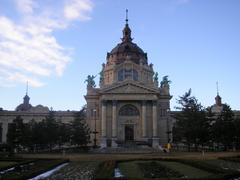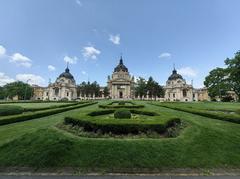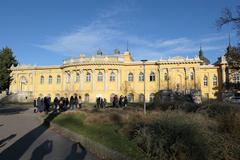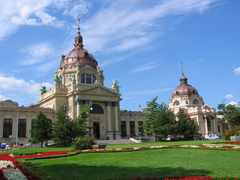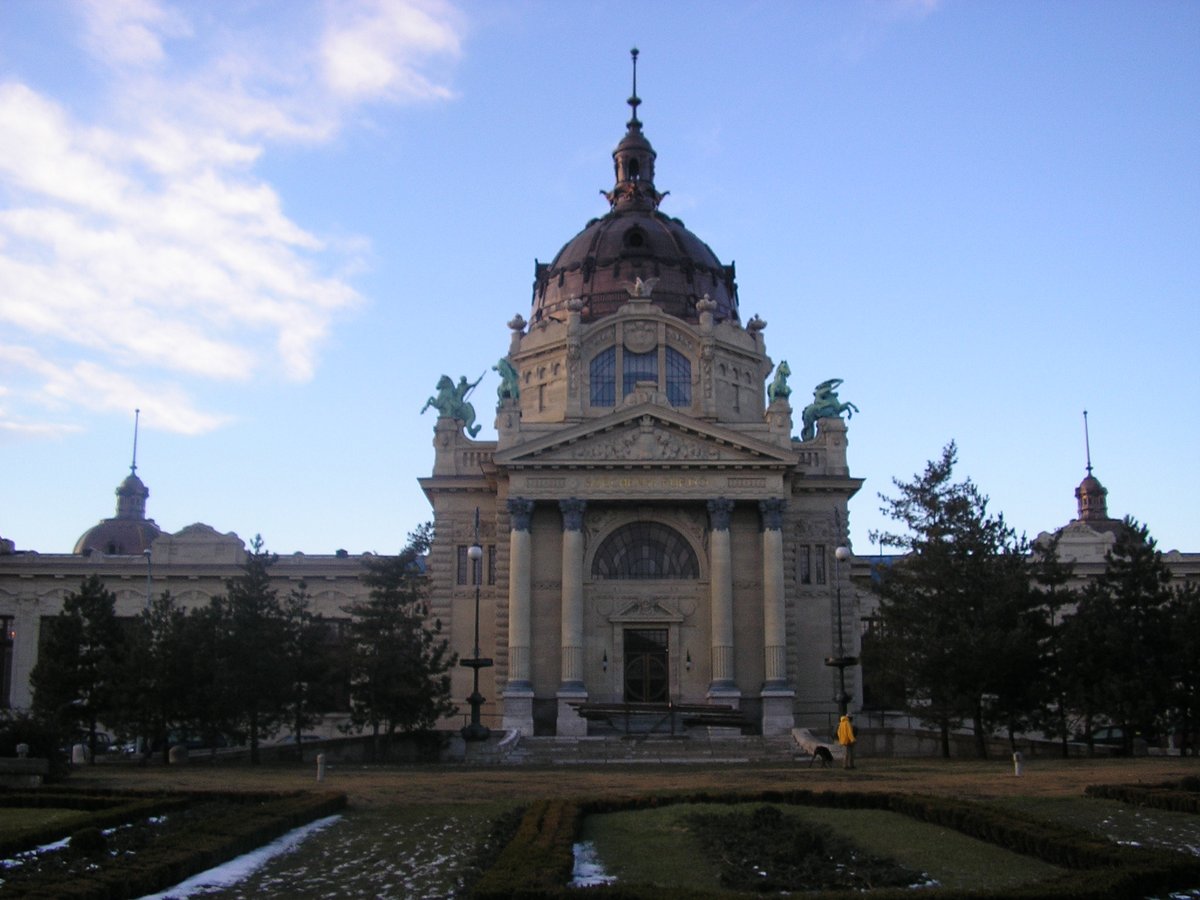
Széchenyi Thermal Bath Budapest: Visiting Hours, Tickets, and Travel Guide
Date: 14/06/2025
Introduction
Nestled in Budapest’s City Park (Városliget), Széchenyi Thermal Bath is one of Europe’s largest and most famous thermal complexes, renowned for its healing mineral waters, Neo-Baroque architecture, and vibrant local culture. This comprehensive guide details everything a visitor needs to know: from the bath’s fascinating history and architectural highlights to practical information about Széchenyi Thermal Bath visiting hours, ticket options, amenities, and tips for a memorable experience. Whether you’re seeking relaxation, wellness, or a glimpse into Budapest’s spa tradition, Széchenyi Bath is a must-visit landmark (szechenyibath.hu, budapest-baths.com, budappest.com).
Table of Contents
- History and Significance
- Architecture and Layout
- Facilities and Amenities
- Visitor Information: Hours, Tickets, Accessibility
- Special Experiences and Events
- Nearby Attractions and Travel Tips
- FAQs
- Conclusion and Visitor Tips
- Sources
History and Significance
Origins and Early Development
Budapest’s spa culture traces back to Roman times, with public baths established at Aquincum, the forerunner of modern Budapest (thermal-baths-budapest.com). The city’s spa tradition flourished under Ottoman rule, introducing Turkish-style bathhouses and rituals (dailynewshungary.com).
The Széchenyi Bath story began in 1865, when engineer Vilmos Zsigmondy drilled deep beneath City Park, discovering a powerful artesian thermal spring by 1879 (wikipedia.org). A modest “Artesian Bath” opened in 1881, but increasing demand called for a grander complex.
Construction and Architectural Evolution
Designed by Győző Czigler, construction started in 1909, embracing a flamboyant Neo-Baroque style. Széchenyi Bath opened on June 16, 1913, as the first large thermal bath on Pest’s side and one of Europe’s largest spa complexes (budapest-baths.com). Its original 18 pools included private baths, steam rooms, and gender-segregated facilities, all set within ornate facades and domed halls.
A major 1927 expansion introduced three expansive outdoor pools and increased indoor pools to 15, shifting the complex towards coed bathing. A second well drilled in 1938 tapped even hotter thermal water. Renovations in the 1960s and again from 1999–2009 modernized facilities while preserving historic charm (wikipedia.org, szechenyibath.hu).
Cultural Role
The Széchenyi Bath embodies Budapest’s identity as the “City of Spas.” The mineral-rich waters—containing sulfate, calcium, magnesium, and more—are believed to offer therapeutic relief for joint, muscle, and skin ailments (budapestthermalbaths.com). The bath is also a vibrant social hub, hosting chess games in steaming pools, wellness festivals, and popular night-time “sparties” (hellojetlag.com, hungaryunlocked.com). Over a million visitors annually come from all backgrounds to enjoy relaxation, healing, and Budapest’s unique spa culture.
Architecture and Layout
Neo-Baroque Grandeur
Széchenyi Bath is an architectural masterpiece, reflecting early 20th-century Neo-Baroque ambitions. The complex features a symmetrical layout, with a grand domed entrance, elaborate stucco, arches, and marble halls (budapest-baths.com). Decorative motifs—shells, aquatic figures, gilded details—adorn both interior and exterior spaces, creating a palace-like ambiance (imaginoso.com).
Spatial Organization
- Outdoor Pools: Three main outdoor pools (leisure, swimming, and whirlpool) are framed by colonnades and sun terraces. The 50-meter swimming pool is a highlight, open year-round and currently undergoing major renovation (BudAPPest).
- Indoor Pools: 15 indoor pools with varying mineral content and temperatures (18°C–40°C), complemented by steam rooms and saunas (Rick Steves Forum).
- Wellness Areas: Dedicated spaces for massages, mud treatments, physiotherapy, and beauty services.
The bath’s integration with City Park offers scenic views and a tranquil setting, while its proximity to Budapest Zoo and Vajdahunyad Castle enriches the visitor experience (thetouristchecklist.com).
Facilities and Amenities
Pools and Baths
- Outdoor Pools: Three large pools (swimming, thermal, whirlpool) heated between 27°C and 38°C, open year-round (BudAPPest).
- Indoor Pools: 15 pools with unique mineral compositions and temperatures.
- Saunas and Steam Rooms: Multiple options, including Finnish and infrared saunas.
Spa and Wellness Services
- Massages: Traditional, aroma, and medical massages (20–70 minutes).
- Therapies: Mud packs, underwater jet massages, physiotherapy.
- Beauty Treatments: Facials, body scrubs (advance booking recommended).
Changing Facilities and Lockers
- Lockers: Included in ticket price; standard changing rooms.
- Private Cabins: Available for a fee, ideal for privacy and valuables (Rick Steves Forum).
- Towel and Swimsuit Rental: Offered on-site, but bringing your own is more economical.
Additional Amenities
- Cafés and Bars: Snack bars and cafeterias serve drinks and Hungarian specialties.
- Beer Spa: Soak in tubs with beer ingredients and enjoy unlimited draft beer for an extra fee.
- Sun Loungers: Available on a first-come basis.
- Poolside Lockers: Small lockers for valuables outdoors.
Visitor Information: Hours, Tickets, Accessibility
Széchenyi Thermal Bath Visiting Hours
- Typical Hours: 6:00 AM to 10:00 PM daily (budapest-baths.com).
- Special Events: Hours may be extended for “sparties” or altered during renovations—always check the official site before visiting.
Tickets and Prices
- Standard Adult Tickets: €20–25 (44–46 USD) for day access, including locker use.
- Evening/Discount Tickets: Reduced rates after 6 PM.
- Cabin Upgrade: Additional fee for private changing cabins.
- Spa Services: Massages and treatments require separate booking and payment.
- Discounts: Available for students, seniors, Budapest residents, and frequent visitors (see Zsigmondy Club Card) (BudAPPest, Daily News Hungary).
How to Buy Tickets
- Online: Strongly recommended for guaranteed entry and to avoid lines (thebettervacation.com).
- On-site: Available at the entrance, but expect longer waits during peak hours.
Accessibility
- Wheelchair Access: Ramps and accessible changing rooms are provided (szechenyibath.com).
- Navigation: Maps are available; the complex is large, so some older areas may have stairs.
Special Experiences and Events
- “Sparties”: Night-time pool parties with music and lights, usually on Saturdays—advance tickets required.
- Guided Tours: Learn about Széchenyi’s architecture and history.
- Wellness Festivals: Occasional themed events and workshops.
Nearby Attractions and Travel Tips
- Heroes’ Square: Iconic monument a short walk away.
- Vajdahunyad Castle: Picturesque, eclectic architecture in City Park.
- Budapest Zoo and Botanical Garden: Family-friendly and adjacent to the baths.
- Museum of Fine Arts: Near Heroes’ Square.
Getting There: Take the M1 (Millennium Metro) to Széchenyi fürdő station. Buses and trolleybuses also serve the area (budapest.com).
Frequently Asked Questions (FAQ)
What are Széchenyi Thermal Bath’s opening hours?
Typically 6:00 AM–10:00 PM; confirm on the official site.
Can I buy tickets at the entrance?
Yes, but online booking is recommended to avoid queues.
Is Széchenyi Bath family-friendly?
Children under 14 are not permitted as of 2024 (thebettervacation.com).
Is the bath wheelchair accessible?
Yes, with ramps and accessible changing rooms.
What should I bring?
Swimwear, towel, flip-flops, and a swimming cap for the lap pool. Bathrobes are useful in winter (szechenyibath.com).
Are spa treatments included in the ticket?
No, they require separate booking and payment.
When is the best time to visit?
Early mornings, weekdays, and winter for fewer crowds and a magical steam atmosphere.
Bathing Etiquette and Safety Tips
- Mandatory swimwear and showering before pool entry.
- No diving/running; respect quiet zones.
- Hydrate frequently; bring a water bottle.
- Lock up valuables; use waterproof pouches if needed.
- Pregnant women and those with heart conditions should consult their physician before visiting.
Conclusion and Visitor Tips
Széchenyi Thermal Bath is a cornerstone of Budapest’s spa tradition, blending history, wellness, and vibrant social life. To maximize your visit:
- Book tickets online and arrive early for a relaxed experience.
- Bring essentials to avoid high on-site rental costs.
- Explore nearby attractions for a full day in City Park.
- Don’t miss unique local traditions, like chess games in the outdoor pools.
Stay updated by downloading the Audiala app, following us on social media, and reading our related guides to Budapest’s top thermal baths and historical sites. Enjoy your journey into Hungary’s rich spa heritage!
Sources
- Széchenyi Thermal Bath: Visiting Hours, Tickets & Budapest’s Historic Spa Experience (szechenyibath.hu)
- Széchenyi Thermal Bath Visiting Hours, Tickets & Architectural Highlights (budapest-baths.com)
- Széchenyi Thermal Bath Visitor Guide (budappest.com)
- Practical Information and FAQ (szechenyibath.com)
- Budapest Historic Baths Renovated (dailynewshungary.com)
- Budapest Thermal Baths Culture and History (thermal-baths-budapest.com)
- Sizzling Széchenyi Thermal Baths: A Must-Visit Oasis (hungaryunlocked.com)
- Széchenyi Thermal Bath in Budapest Spa Tradition (budapestthermalbaths.com)
- Széchenyi Thermal Bath Tickets and Tips (thebettervacation.com)
- A Guide to Budapest’s Thermal Baths (lonelyplanet.com)
- Budapest Thermal Baths Price and Renovation Plans (BudAPPest)
